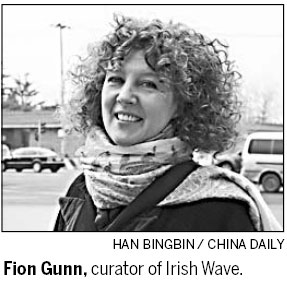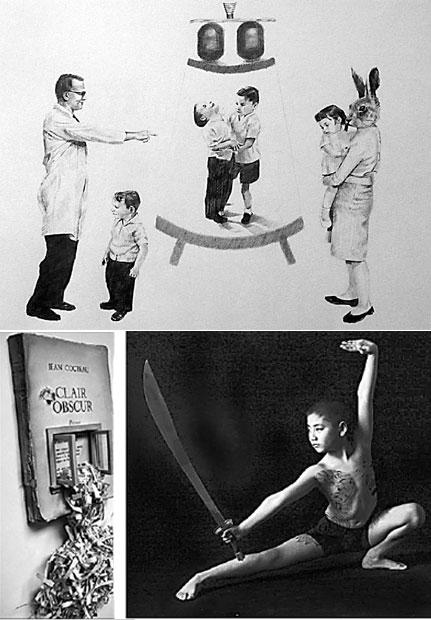Closing the great divide
Updated: 2012-03-11 07:56
By Han Bingbin(China Daily)
|
|||||||
|
Works by both Chinese and Irish artists in the six exhibitions of the Irish Wave feature various art forms such as painting, video, photography and installations. Photos provided to China Daily |
Contemporary art has lost ability to communicate with its audience, and the different genres need to work at better cross-overs. Han Bingbin talks to the curator of the Irish Wave art festival, which aims to cut across the chasms.
For too long, in Fion Gunn's words, the contemporary art scene has been segregated from ordinary society and the dialogue between the artists and the public has somehow disappeared.
The London-based Irish artist and curator finds that "very bad".
She attributes it to the forced division many people make between different art forms. The definition of art thus becomes so narrow that once let down by one genre of art, people tend to dislike art in general.
But good artists can work across these forms and bring them together in an interesting and significant way. It's all about placing the works in a certain context and letting them talk with each other, the curator said.
For example, if there is a painting and a sculpture, Gunn says there should be vibrancy between them so viewers can look at one and understand the other better.
She proves her point with this year's Irish Wave art festival, her brainchild. Each of the six exhibitions will feature various art forms such as painting, video, photography and installation, all united under one theme.
The themes will cover artistic fields in which both China and Ireland share a long tradition, such as "landscape art in the context of culture and memory" and "literature as an inspiration for art".
The works are contributed by an almost equal number of Chinese and Irish artists, whose ages range from 20 to 50. Gunn hopes the diversity will help viewers enjoy and understand art through observing the conversations between the works in terms of differences and similarities.
"Each exhibition has something for many people, not just for one kind of people," says Gunn, who believes her role as a curator is "slightly educational".
But even as she tries to broaden the range of artistic styles and art forms, she has kept one bias in her criteria when choosing the works. Out of the 61 Irish artists, 55 are women. Gunn says this gender preference is her personal effort to make up for her conviction that women are often under-represented.
"I would not say women are better than men. They are at least not worse than men. In terms of talent, it's the same," she says.

But, Gunn says, the problem is that museums and big art galleries don't represent women and they don't buy women's work. That's why a few years ago, she says, the Pompidou Center in Paris held an 18-month-long exhibition by women artists.
She concluded after visiting the exhibition several times that women do have a slightly different angle while looking at the world, which deserves to be represented in the diversity of art.
"It's not just about sexism. I think it's because girls haven't got into education. When I graduated (from art college), it was special because 60 percent (of graduates) were girls. Before that, it had been mainly men. Then it began to change. Now it's about 50 to 50," she says.
She is happy to see China's women artists expanding their territory. But she's sad to note that many produce "low grade" work because of the expectation that they should do something pretty and decorative. That doesn't interest Gunn at all.
"I think women should deal with important subjects that I think are intellectual."
This is why one of her Irish Wave exhibitions will be titled Intimate Revolution. Here, Gunn hopes to show the intellectual side of women artists and reveal the disadvantages of women in society on an even more profound level.
Women artists from both countries will look at how, at times of social change such as war and revolution, women had helped make the changes. But after the revolutions, their roles are all but forgotten.
"From the works of some of the Chinese artists in this exhibition, you can sense the tension there. There is the difficulty in dealing with the power that men have in society."
Contact the writer at hanbingbin@chinadaily.com.cn.
If you go
Instruments of Pleasure: Starts March 11 at National Center for the Performing Arts, west of Tian'anmen Square, Beijing
Convergence 3: Starts March 24 at Space Gallery, 798 Art District, 4 Jiuxianqiao Lu, Chaoyang district, Beijing
Intimate Revolution: Discourse on Disappointment: Started March 8 at Siemens Arts Space, 798 Art District, Beijing
Hidden Meanings: Started March 9 at Yan Chao Collection Gallery, 21F Lianri International, 18 Langjiayuan South, Chaoyang district, Beijing
Elements: Starts March 16 at Shengling Gallery, 570 Huaihai Xilu, Shanghai
Telling Tales: Starts March 12 at Irish Center, 227 Huangpi Beilu, Shanghai
For detailed information, please visit http://bigsmallartists.com.
(China Daily 03/11/2012 page15)
